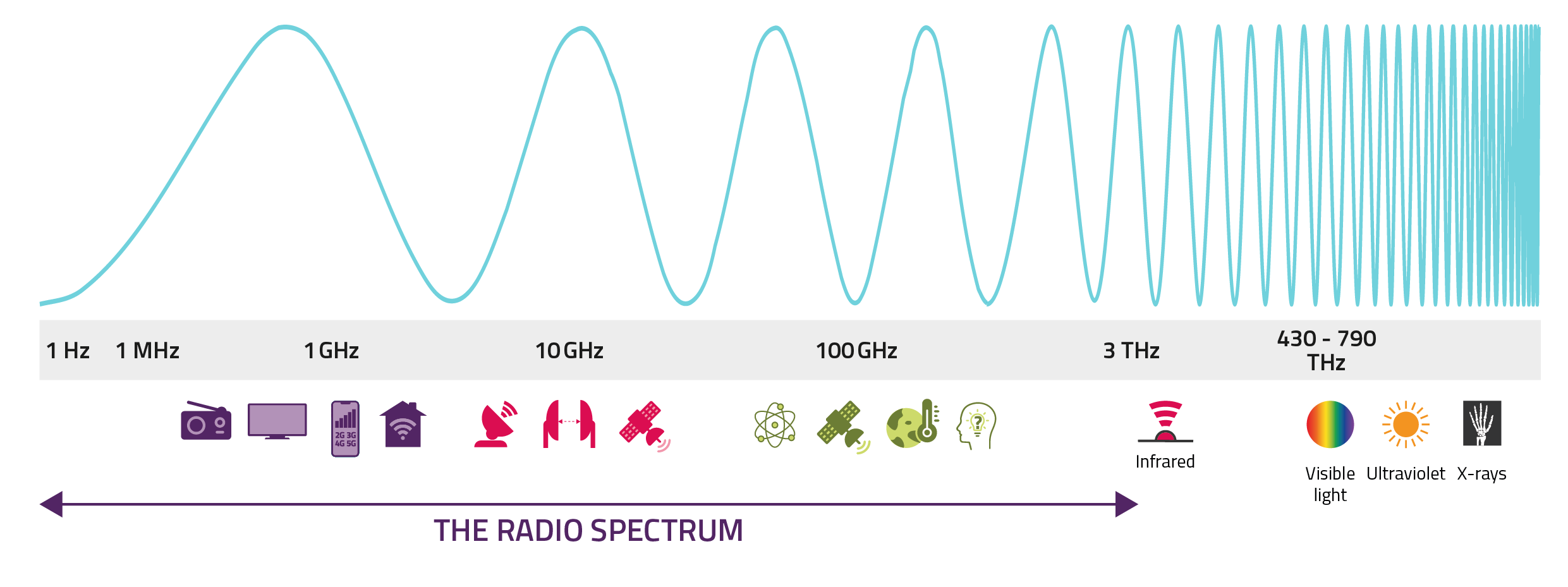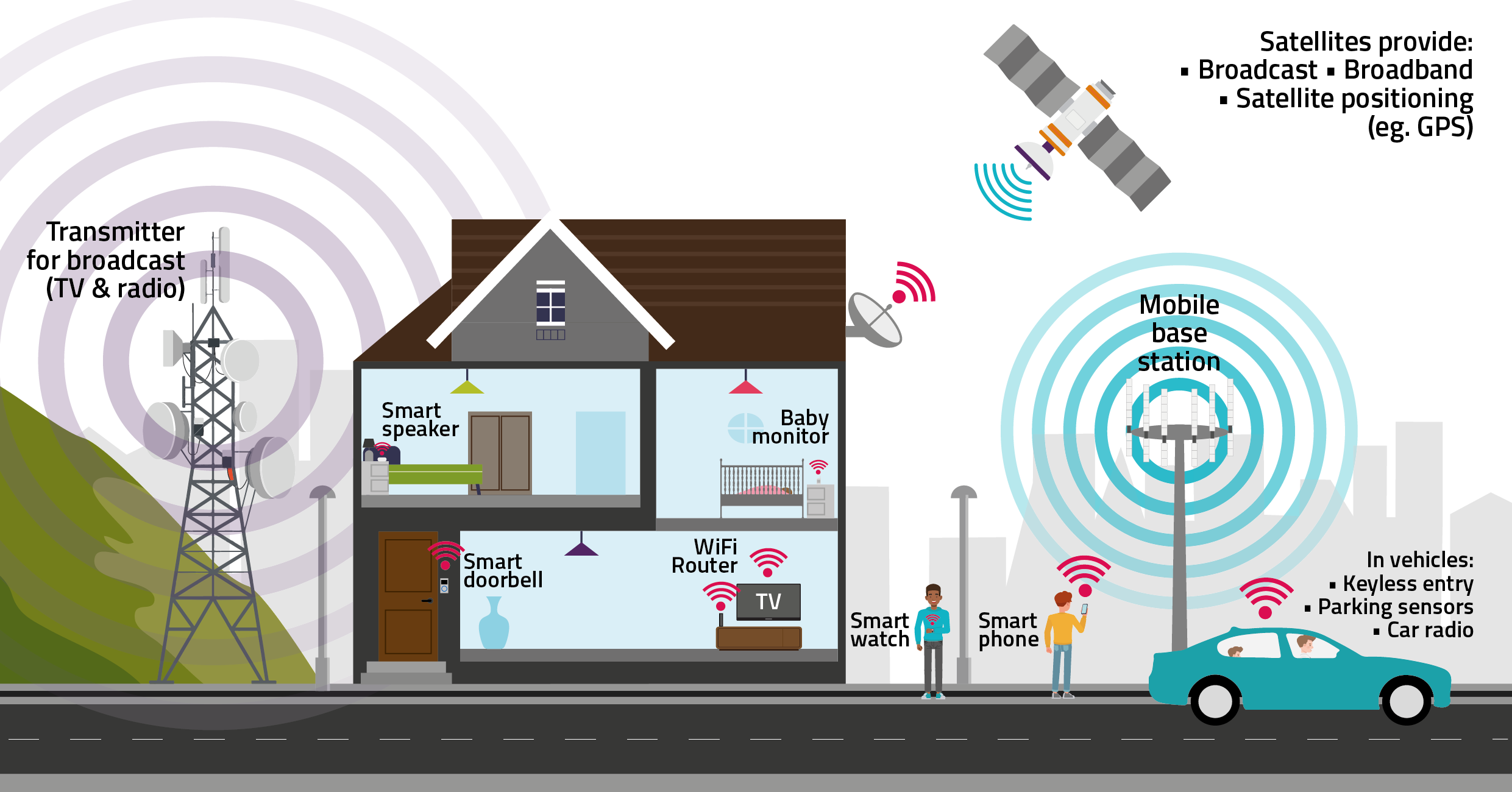
You can’t see or feel radio spectrum. But any device that communicates wirelessly needs spectrum – these include televisions, car key fobs, baby monitors, wireless microphones and satellites.
Mobile phones also use spectrum to connect to a local mast enabling you to make calls and access the internet.
Only a limited amount of spectrum is available, so it needs to be managed carefully. Certain bands of spectrum are also used for different purposes. For example, mobile companies use different parts of the spectrum to TV companies. So, it needs to be managed to prevent services interfering and causing disruption to people and businesses.
Radio spectrum, also known as radio waves, forms the lower part of the wider electromagnetic spectrum, just below infrared and visible light.
The electromagnetic spectrum

The ability of radio waves to travel through the air, space and solid materials means they can be used for radiocommunication. Using these waves allows television to be broadcast into your home, or how you can have a conversation using a mobile phone. But there are many more uses for these waves.
At the most basic level, a radiocommunications system involves a transmitter taking information (typically data) and converting it into a radio signal at a particular frequency, and a receiver taking the radio signal and extracting that information. However, sometimes this communication between transmitter and receiver can be disrupted by interference, such as signals from other transmitters. This can degrade or potentially prevent communications altogether.
For this reason, radio spectrum cannot be used in an uncontrolled way. To prevent interference between users, the transmission of radio waves is regulated by national laws.
What is Ofcom’s role in spectrum?
Ofcom is responsible for authorising and managing use of radio spectrum in the UK and represents the UK internationally.
The radio spectrum is a finite resource – we cannot ‘make’ new frequencies. Demand for access to the spectrum has continually grown and will continue to grow in the future. As a result, we and industry need to find ways to squeeze in more users without causing interference. Although we cannot create new spectrum, new technologies can enable it to be used more effectively, so it can serve more users and uses, and help transform the way we live and work.
How is spectrum used in the UK?
Everyone in the UK – people, businesses and public organisations – uses a range of wireless services and technologies on a daily basis.
Some of the most prevalent consumer uses of spectrum include:
- Browsing the internet at home or on the move using a mobile network or a Wi-Fi connection.
- Making a mobile phone call or sending a text message using a mobile network.
- Watching television or listening to the radio, via an aerial or satellite dish.
- Using a Bluetooth connection to connect to personal and home devices.
- Accessing navigation services on a smartphone or in-car satnav using a signal provided by satellite.
- Satellite and wireless broadband for homes that are not connected to a reliable fixed network, for example those in remote areas.

Examples of spectrum uses
In addition to consumer uses of spectrum, many businesses and organisations make specialised use of spectrum to help them effectively manage their business and provide services. Some of the main commercial uses of spectrum include:
- Ships use a range of maritime radio equipment for communications, navigation, to keep track of other vessels and to ensure the safety of people on board.
- A typical commercial aircraft might have over twenty aeronautical radio systems on board for communication, navigation and surveillance functions.
- Business radio users range from taxi companies and factories, to hospitals, care homes, industrial sites, utilities networks and transport operators.
- Radio astronomy and other space science activities contribute to our knowledge of the universe. For example, earth observation satellites collect data about the earth and its atmosphere that is used for weather forecasting, environmental monitoring, climate change research and many other applications.
- Broadcasters and event organisers use programme-making and special events equipment (such as wireless microphones, wireless cameras, in-ear monitors) for news gathering, sports events, live concerts, films, theatre, religious and educational activities.
- Mobile operators, broadcasters and others use fixed links (also known as microwave links) to send large amounts of data wirelessly between two or more points, such as connecting a mobile base station to the core network.
Spectrum is also significantly used by the public sector, with the majority of this spectrum being available for defence use.
Find out more
Use our interactive spectrum map to find out how different spectrum bands are used in the United Kingdom.
